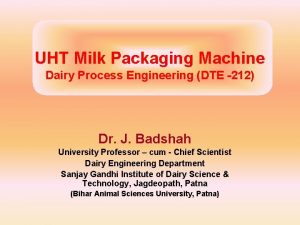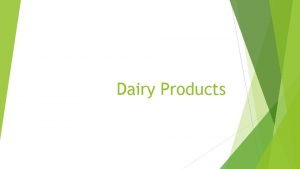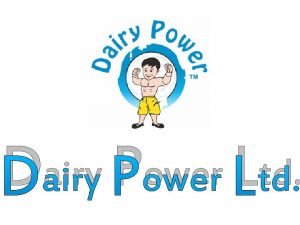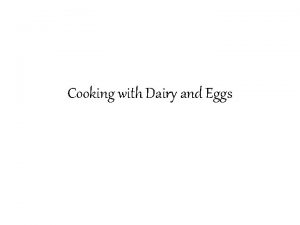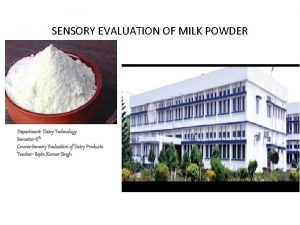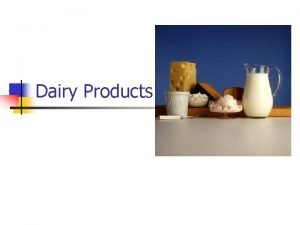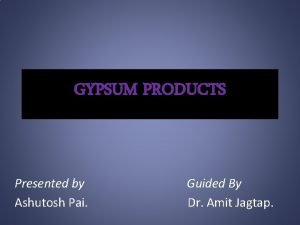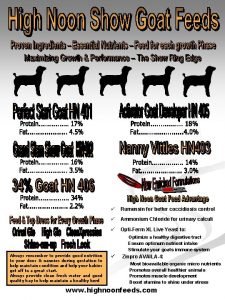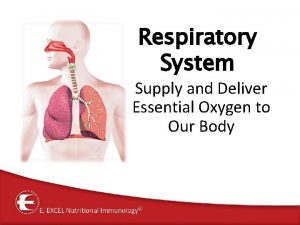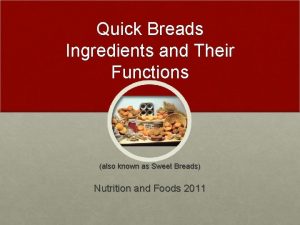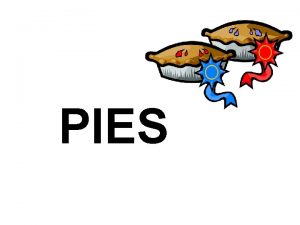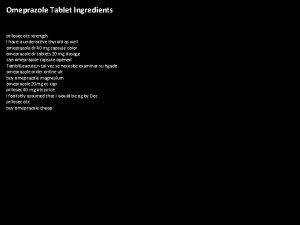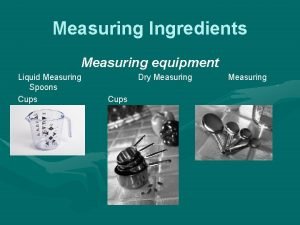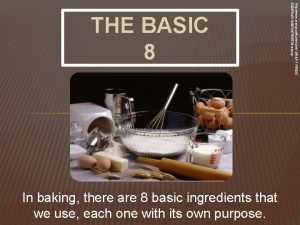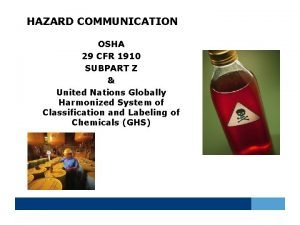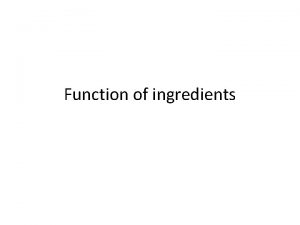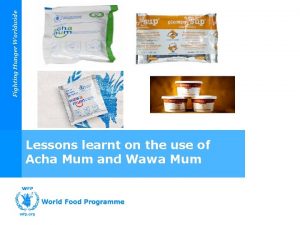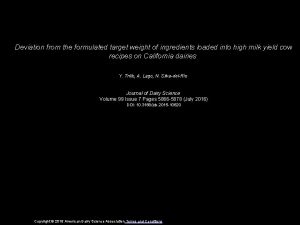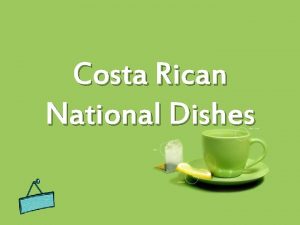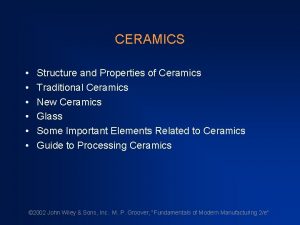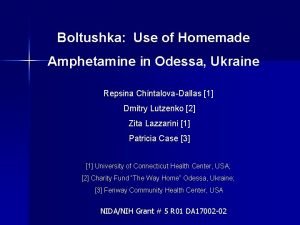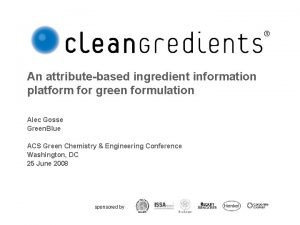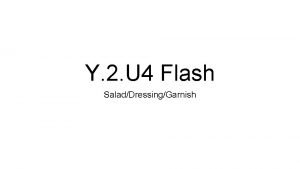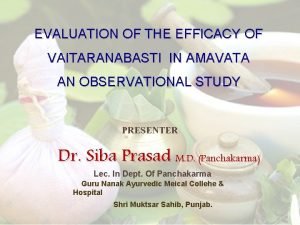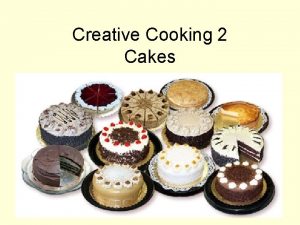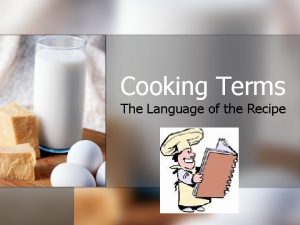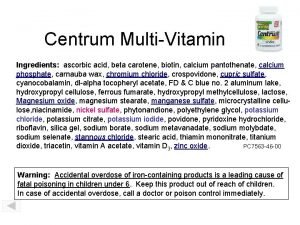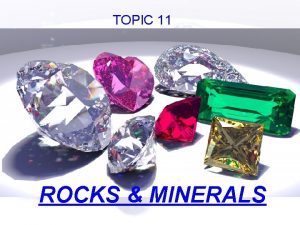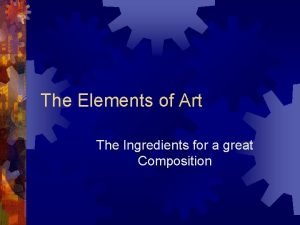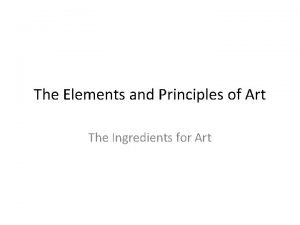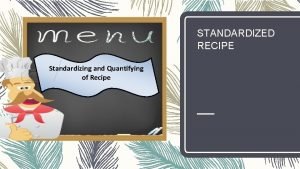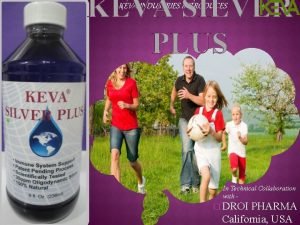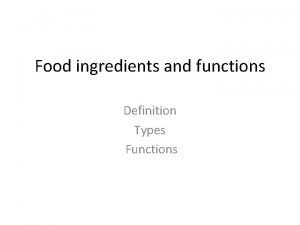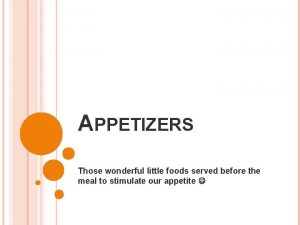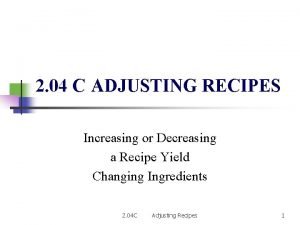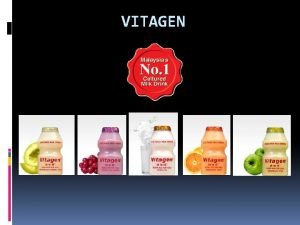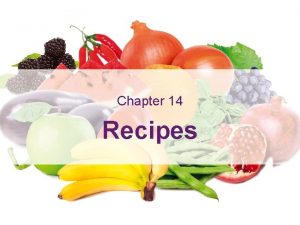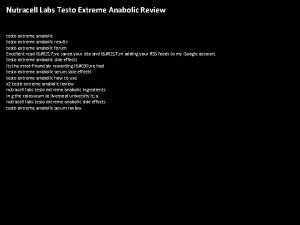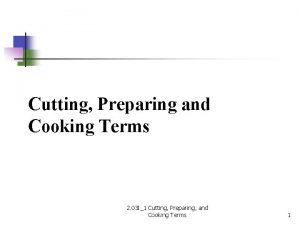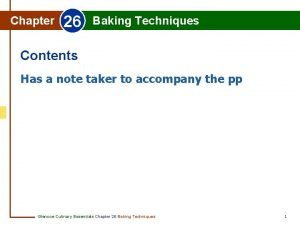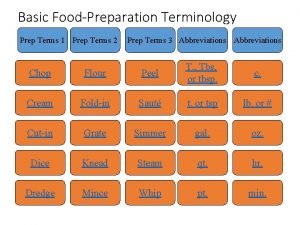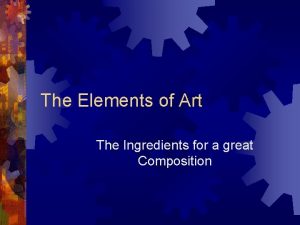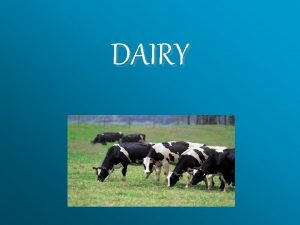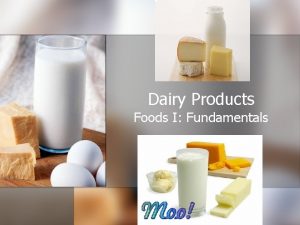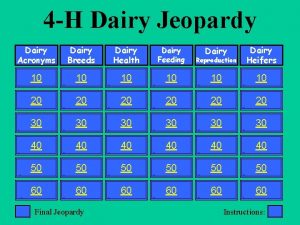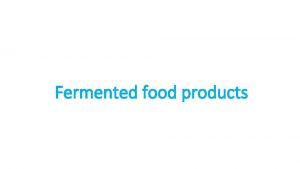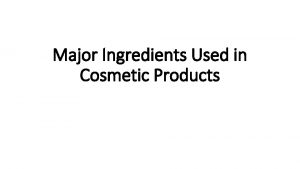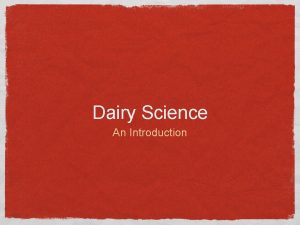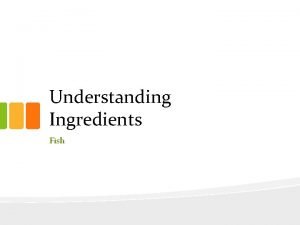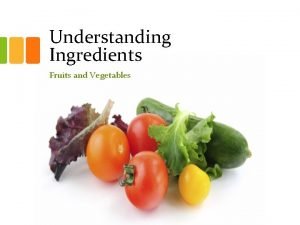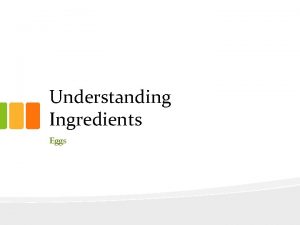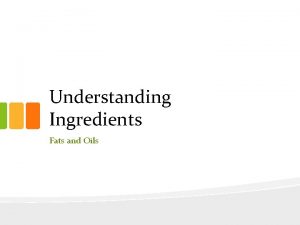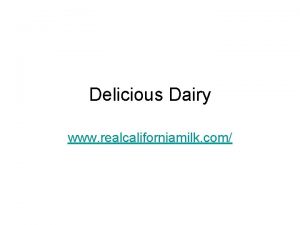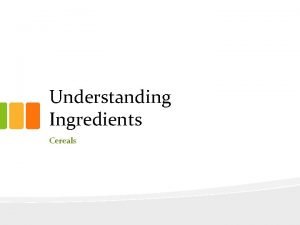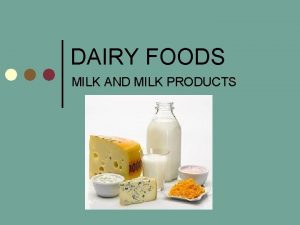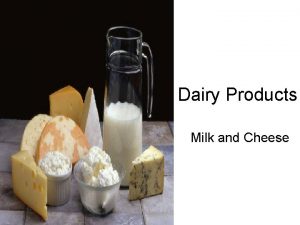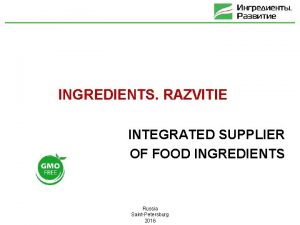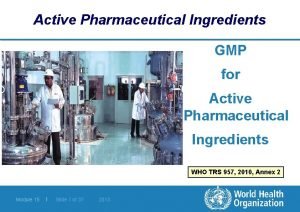Understanding Ingredients Dairy Products Topics Introduction Types of











































































- Slides: 75

Understanding Ingredients Dairy Products

Topics • Introduction • Types of Dairy Products • Milk • Cheese • Yoghurt • Cream • Butter 2

Introduction 3

Introduction • Milk is produced by mammals such as cows, sheep, goats • Babies of most species rely on milk for many months before they eat other food • Milk contains total nutrition for the growth and development of babies, therefore babies do not need to eat other food • Milk can also be made into many kinds of food, in general, they are called dairy products 4

Types of Dairy Products 5

Types of Dairy Products There are many products made from milk, the most commonly used dairy products include: • Milk • Cheese • Yoghurt • Cream • Butter 6

Types of Dairy Products Non-dairy • More economical than real dairy products because it does not contain the costly butterfat • It consists of a vegetable fat or oil and nonfat milk solids • The vegetable fat has traditionally been coconut oil, but it may be partially hydrogenated corn, cottonseed, palm, or soy oil • Does not contain cholesterol Non-Bovine Milk • Includes milk from goats (Mediterranean countries), sheep (southern Europe), and reindeer (northern Europe) 7

The following chart shows that raw milk can be manufactured into different dairy products: Skimmed milk Whey Yoghurt Cheese Drinking milk Casein Cream Raw milk Concentrated milk Butter Evaporated milk Milk powder Buttermilk Condensed milk 8

Milk 9

Types of Milk Types of milk based on different heat treatment: • Homogenised milk – Homogenisation is to prevent creaming, or the rising of fat – It is applied to whole milk or low-fat milk – Milk is heated to 55 -65 o. C at a high pressure of 200 atmospheres – Fat globules reduced in size; no visible cream separation occurs – Increases whiteness of milk; less susceptible to oxidised flavour 10

Types of Milk Types of milk based on different heat treatment (cont’d): • Pasteurised milk – Pasteurisation kill bacteria and inactivate enzymes – Low Temp Long Time (LTLT) – 63 o. C for > 30 mins – High Temp Short Time (HTST) – 75 o. C for >15 sec – Listeria and Coxiella species may survive at 72 o. C – Cooled to 4ºC immediately after heating 11

Types of Milk Types of milk based on different heat treatment (cont’d): • Sterilised milk – In-bottle sterilisation – Milk is filled into bottles, then heated at 104 -110 o. C for 30 -40 min or 110 -120 o. C for 15 -20 min 12

Types of Milk Types of milk based on different heat treatment (cont’d): • Ultra-Heat Treatment (UHT) – Milk is rapidly heated to 135 -150 o. C for at least 1 sec and then quickly cooled – All microorganisms are destroyed – Milk may be safely stored up to 3 months or longer 13

Types of Milk Types of milk based on modification of components: • Whole milk – Milk fat is standardised to 3. 25 - 3. 7% from raw milk of 3. 25 – 5% – Full flavour and smooth texture • Low fat milk – Milk fat is standardised to 1. 5 – 1. 8% • Skimmed milk – Milk fat is standardised to < 0. 5% • High-calcium milk – It contains a higher level of calcium than regular milk 14

Types of Milk Legislative requirement on composition of milk and milk products Milk and milk products Legal requirement on fat percentage Milk and reconstituted milk Not less than 3. 25% of milk fat Milk beverage Not less than 0. 1% of milk fat Skimmed milk Not more than 0. 3% of milk fat Semi-skimmed milk Not less than 1. 5% and not more than 1. 8% of milk fat Sweetened condensed or evaporated milk Not less than 8% of milk fat Unsweetened condensed or evaporated milk Not less than 7. 8% of milk fat 15

Types of Milk Legislative requirement on composition of milk and milk products Milk and milk products Legal requirement on fat percentage Dried full cream milk Not less than 26% Dried partly skimmed milk Less than 26 and not less than 1. 5% Dried skimmed milk Less than 1. 5% 16

Types of Milk Types of milk based on modification of components (cont’d): • Evaporated milk – Unsweetened concentrated milk – Milk is concentrated through the process of evaporation in a vacuum chamber at 50 – 55 o. C – Volume is reduced to 60% – Canning and sterilisation are performed – The high temperature used in processing evaporated milk may produce a light tan colour due to Maillard reactions between the milk protein and the milk sugar, lactose 17

Types of Milk Types of milk based on modification of components (cont’d): • Condensed milk – Sweetened concentrated milk – Milk is concentrated with approximately 60% of the water removed and sugar levels of 40– 45% in the finished product – Sugar is added prior to evaporation – Sweetened condensed milk is pasteurised, but not sterilised, because the high sugar content plays a role in preventing bacterial growth 18

Types of Milk Types of milk based on modification of components (cont’d): • Dried milk – Dried milk powder may be processed from either pasteurised whole milk or skimmed milk – Nowadays, dried milk is usually made by spray drying – Milk is first condensed by removing two-thirds of the water and is typically sprayed into a heated vacuum chamber (spray drying) to dry to less than 5% moisture levels – The drying process has no appreciable effect on the nutritive value of milk – Most skimmed dried milk is fortified with vitamins A and D 19

Types of Milk Types of milk based on modification of components (cont’d): • Flavoured milk – Made with addition of sugar, colourings and artificial or natural flavourings – E. g. chocolate milk, coffee milk, strawberry milk, and papaya milk 20

Structures of Milk • Milk is a dispersion of milk fat globules (fat particles) and casein micelles (protein particles) in a continuous phase of water, sugar (lactose), whey proteins, and minerals • Milk Plasma is left after separating the fat globules; equivalent to skim milk for practical purposes • Milk Serum is left after removing both fat globules and casein micelles; equivalent to cheese whey for most practical purposes • Coagulation is what happens when the casein micelles stick together • Because casein particles are hydrophobic (they hate water) their natural tendency is to aggregate (clump together) 21

Milk Structures of Milk plasma (skimmed milk) Milk serum (whey) Casein micelles Fat globules To make cheese To make cream 22

Structures of Milk • Milk is made of aqueous and oil Aqueous • Water • Lactose • Protein • Casein • Whey • Vitamins • Minerals Oil/Fat • • Fat globules Fat soluble vitamins Selected proteins Enzymes (lipases) 23

Nutritive Value of Milk Proteins • Milk contains high biological proteins – casein and whey • 8 -ounce (~ 236 ml) serving of fluid milk contains 8 g of protein 24

Nutritive Value of Milk Fats • The total lipid content of cow milk is in the range of 3– 5% but the content depends on a wide variety of factors, including, breed, diet and health of the animal • Fat percentage in drinking milk is altered by a process called standardisation Type of Milk Fat Percentage Raw 3. 25 – 5% Whole 3. 25 – 3. 7% Low fat 1. 5 – 2% Skimmed < 0. 5% 25

Nutritive Value of Milk Carbohydrates • Almost 5% of milk is carbohydrates • Most carbohydrate in milk is sugar, in the form of lactose • Lactose provides almost half of the calories of milk and gives milk its sweet flavour • Lactose is a disaccharide made of two simple sugars, glucose and galactose • An enzyme produced in the gut called lactase breaks the disaccharide producing glucose and galactose for the body to absorb and use • A deficiency of lactase results in lactose intolerance • People who are lactose-intolerant are unable to fully digest the sugar (lactose) in milk, and symptoms may include diarrhoea, gas and bloating after eating or drinking dairy products 26

Nutritive Value of Milk Minerals • Calcium is one of the major minerals in milk and dairy products • In cow’s milk, its concentration is about 1200 mg/L • Milk and dairy products are considered as one of the best sources of calcium • Phosphorous and magnesium are important elements in milk and dairy products • The major part of the calcium (99%) and phosphorous (85%) in the human organism is located in the bone tissues • Drinking milk is advocated to prevent osteoporosis 27

Nutritive Value of Milk Vitamins • Milk is an essential source of some vitamins such as vitamin A, vitamin B 2 and vitamin B 12 • Some milk and dairy products are fortified with vitamins A and D • Milk also contains the amino acid tryptophan, a precursor to niacin (vitamin B 3) Water • Almost 90% of milk is water 28

Choice and Storage of Milk Choosing milk • Check the date label when buying • Check that the package is intact • For bottled milk , check that there are no clotted pieces • For canned milk , check that cans are not dented or bulged 29

Choice and Storage of Milk Storing milk • Store fresh milk in the refrigerator. Consume before the expiry date • Keep unopened cartons of UHT milk, cans of evaporated and condensed milk in a cool dry place • Once the container of milk is opened, the milk should be kept in the refrigerator away from strong-smelling foods • Cover dried milk powder tightly to avoid formation of lumps due to humidity 30

Uses of Milk in Cooking / Diet Milk can be used in many different ways, e. g. : • Drinks – milk shakes, hot chocolate, café latte • Desserts – steamed egg custard, panna cotta, ice cream, egg tart • Savoury sauces – white sauce, alfredo sauce • Sweet sauces – chocolate sauce, caramel sauce • Batter – pancakes, fritters • Soups – cream of mushroom soup, clam chowder • Bakery products – cakes, biscuits, breads • Breakfast cereals • Milk products such as cheese, yoghurt, cream, butter 31

Food and Nutrition Labelling of Milk Labelling of milk is controlled in Hong Kong legislation: • List of ingredients – Pre-packaged food shall be legibly marked or labelled with a list of ingredients • List of allergenic substance – Milk and milk products (including lactose) is an allergenic substance, the name shall be specified in the list of ingredients • Appropriate durability indication – Indication of “best before” or “use by” date 32

Food and Nutrition Labelling of Milk Labelling of milk is controlled in Hong Kong legislation: • Nutrition labelling – Pre-packaged food shall be marked or labelled with its energy value and nutrient content • Nutrition claim – If any nutrition claim is made on the food label or in any advertisement, the nutrient in concern shall be marked or labelled in the nutrition labelling 33

Cheese 34

Introduction of Cheese “Cheese shall be the solid or semi-solid product obtained by coagulating milk with rennet or acid, with or without the addition of ripening ferments, seasonings, salt (sodium chloride) and permitted colouring matter. ” ~~ Hong Kong Legislation 35

Introduction of Cheese • Cheese is a concentrated form of milk that contains casein, various percentages of fat, primarily saturated fat, mineral salts, and a small portion of milk serum (whey proteins, lactose, and water-soluble vitamins) • It is the curd that forms as a result of casein coagulation by the enzyme rennin (also known as chymosin) or lactic acid • Rennin is a proteolytic enzyme synthesized by chief cells in the stomach • The role of rennin in digestion is to curdle or coagulate milk in the stomach, a process of considerable importance in the very young animal 36

Introduction of Cheese Legend of Cheese • In ancient times, people used animal skins and inflated internal organs to store food • Cheese-making process was discovered accidentally by storing milk in a container made from the stomach of an animal • The stomach contained rennet • Rennet caused the milk to be separated into curd and whey 37

Introduction of Cheese • After coagulation of protein, milk curd may further be treated by heat, pressure, addition of salt and ripening with selected microorganisms • When curd is pressed, whey is drained from it • The flavour of curd develops as it is salted and ripened. • Addition of salt can also help to preserve the cheese • The ripening process may take days, weeks, months, or years • Microorganisms are added in some cheese varieties to provide different taste and texture 38

A Simple Flow Chart for Cheese-Making Curding Draining and pressing • Denaturation and aggregation of proteins • Coagulation of fat globules • Removal of water and water-soluble components like lactose • Setting protein-fat structure • Chemical changes brought about by reactions with oxygen and fats/ proteins/organic molecules Aging and • Reactions catalysed by enzymes from bacteria or other microbes ripening 39

Types of Cheese Classification of Cheese • In general, cheese is classified according to 1) The moisture content, producing either very hard, semisoft, or soft cheeses 2) The kind and extent of ripening 3) The types of cheese available to the consumers 40

Types of Cheese Classification according to moisture content • It is a common but inexact practice to classify cheese based on moisture content • Many types of cheese are made in softer or firmer variations • The main factor that controls cheese hardness is moisture content Firmer Cheese Softer Cheese Lower moisture content, 30 – 40% Higher moisture content, 40 – 75% water Very tiny fat globules are formed, near-perfect emulsion Large fat globules are formed, only slightly emulsified Longer ripening process Shorter ripening process Longer shelf-life Shorter shelf-life 41

Types of Cheese Examples of cheeses in different moisture content • Romano • Camembert • Cottage cheese • Cream cheese • • Very hard Hard Soft Semisoft Cheddar Edam Gouda Parmesan • Brick • Roquefort 42

Types of Cheese Ripening • Ripening refers to the chemical and physical changes that occur in the cheese in the time between curd precipitation and satisfactory completion of texture, flavour, aroma, and colour development • Ripening may require 2– 12 months • Carbohydrate lactose is fermented by lactase to lactic acid • Fat is hydrolyzed by lipase • Protein undergoes mild proteolysis to amino acids by rennin 43

Types of Cheese Classification according to the kind and extent of ripening • Cheeses that are not ripened, such as cottage cheese or cream cheese • Cheeses may be ripened with bacteria, the holes or eye formation in Swiss cheese is evidence of gas-producing bacteria that exist throughout the interior of the cheese • Cheeses that are ripened by inoculation of the milk with bacteria and yeast, such as brick and Limburger ripen from the surface to the interior of the cheese • Cheeses that are ripened by mould, e. g. Camembert and Brie are ripened by mould that is sprayed onto the surface of the cheese • Blue cheese are ripen by introducing Penicillium roqueforti internally, so that the mould can grow inside the cheese 44

Types of Cheese Classification according to the types of cheese available to the consumers: • Natural cheese is the curd of precipitated casein • Processed cheese is prepared by comminuting and mixing different cheeses, with the aid of heat • An emulsifier is added to make it into a homogeneous plastic mass Natural cheese Processed cheese Whey is pressed out Can be made by a single cheese or mixing two or more varieties of cheese No emulsifier Contains emulsifier Texture varies among different varieties Softer, smoother, and more consistent texture Salt is added Seasoning and colourant may be added 45

Nutritive Value of Cheese • Cheese is a concentrated form of milk, therefore the nutrients found in cheese is very similar to those in milk, only in higher amount • With the addition of salt in the cheese-making process, the sodium content of cheese also increases 46

Nutritive Value of Cheese Legislative requirement on composition of milk and milk products Milk and milk products Legal requirement on fat percentage Cheese Not less than 30% of milk fat in its water-free substance Cream cheese Not less than 60% of milk fat in its water-free substance Whole-milk cheese Not less than 50% of milk fat in its water-free substance Skim-milk cheese Not less than 10% of milk fat in its water-free substance 47

Choice and Storage of Cheese Choosing cheese • Check the expiry date • Cheese should be fresh and not dried out • Check that the package is intact • There should not be abnormal mould growth 48

Choice and Storage of Cheese Storing cheese • Wrap blocks of cheese in foil and keep in polythene bag or plastic container • Store in the compartment in the refrigerator away from strong smelling foods • Store grated cheese in covered container in the refrigerator 49

Uses of Cheese in Cooking / Diet Cheese can be used in many different ways: • Appetizer / soup - e. g. Greek Salad, cheeseboard, French Onion Soup, Mozzarella Balls • Main course – e. g. pizza, lasagna, burger, quiche, tacos/quesadillas, risotto, ravioli • Sauce / dip – e. g. cheese sauce, Chile con queso, Fondue • Dessert – e. g. Tiramisu, cheesecake • Snack – e. g. cheese on toast, cheese dog, cheese scone, sandwiches, cheese tart 50

Food and Nutrition Labelling of Cheese [Similar to milk; refer to the section on “Food and Nutrition Labelling of Milk”] 51

Yoghurt 52

Introduction of Yoghurt • Yoghurt is made from skimmed or full cream milk • It is thick in consistency and sour in taste • It is also a cultured or fermented milk product, which means a starter culture is added as ingredient • Starter culture commonly used: – Lactic acid bacteria • Lactobacillus Bulgaricus 保加利亞乳酸桿菌 • Streptococcus thermophilus 嗜熱鏈球菌 • Lactobacillus casei 乾酪乳酸桿菌 • Starter culture convert lactose to lactic acid to produce acidic flavour 53

Types of Yoghurt Classification of Yoghurt: • Plain yoghurt • Flavoured yoghurt – Contains other ingredients such as strawberry, blueberry, raspberry, peach, banana, vanilla flavouring • Yoghurt drink – The coagulum is broken by stirring prior to packing • Frozen yoghurt – Yoghurt is cooled in freezer, similar to production of ice cream – Texture influenced by distribution of ice crystals • Greek yoghurt – Higher solids content (higher protein) than regular yogurt and is perceived as being less acidic – Traditionally, product does not contain stabilizer 54

Nutritive Value of Yoghurt • Contains high biological value proteins • Low in energy value • Contains vitamin B complex and calcium • Nutrient composition of yoghurt in general: – – – Fat: 0. 5 -3. 0% Lactose: 3 -4. 5% Milk-Solid-Not-Fat: 11 -13% Stabiliser: 0. 3 -0. 5% Fruit: 12 -18% Acidity (as Lactic Acid): 0. 9% • Lactic acid bacteria in yoghurt are examples of probiotics which offer health benefits such as immune stimulation and positive balance to the gastrointestinal microflora 55

Choice and Storage of Yoghurt Choosing yoghurt • Check the expiry date • Check that the package is intact Storing yoghurt • Store in refrigerator according to labelling instruction 56

Uses of Yoghurt in Cooking / Diet • Plain yoghurt or Greek yoghurt can be – combined with fruit or other ingredients (such as nuts) and eaten as a meal or dessert – used as an ingredient to make smoothies – used as a base for low/nonfat dressing for salads – used as a topping for potatoes and vegetables – used as a substitute of cream or sour cream in making sauces for a meal • Flavoured yoghurt may be served with breakfast cereals • Yoghurt drink and frozen yoghurt can be eaten as snacks 57

Food and Nutrition Labelling of Yoghurt [Similar to milk; refer to the section on “Food and Nutrition Labelling of Milk”] 58

Cream 59

Introduction of Cream • Cream is the high-fat component separated from whole milk • It has a higher proportion of fat droplets to milk than regular fluid milk • Due to this high fat content, some yellow, fat-soluble pigments may be seen 60

Types of Cream Liquid creams available for use in foods include the following: Types of cream Percentage of butterfat Light (single) cream 18% Whipping cream 35% Heavy (double) cream 48% “Half-and-half” cream - Diluted with nonfat milk 10. 5% Whipping cream packaged under pressure in aerosol cans - Contains fat, sugar, flavoring, emulsifiers, and stabilizer may be nonfat or contain various levels of fat Sour cream - Fermented cream with lactic acid bacteria 18 – 20 % 61

Types of Cream Legislative requirement on composition of milk and milk products Milk and milk products Legal requirement on fat percentage Sterilized cream Not less than 23% milk fat Half cream and sterilized half cream Not less than 12% milk fat Whipping cream and whipped cream Not less than 35% milk fat Double cream and thick cream Not less than 48% milk fat The product known as “half and half” consisting of a mixture of milk and cream Not less than 11. 5% milk fat 62

Nutritive Value of Cream • Low in animal protein content • Rich in fats • Contains a good amount of vitamin A • Nutrient composition of cream in general: – Animal protein: 2. 4% – Fats: 21. 2% – Milk sugar: 3. 0% – Vitamins and minerals: 1. 4% – Water: 72% 63

Choice and Storage of Cream Choosing cream • Check the expiry date • Check that the package is intact Storing cream • Store in refrigerator according to labelling instruction • Keep opened cream refrigerated 64

Uses of Cream in Cooking / Diet • Cream with lower fat percentage can be used in sweet or savoury dishes • Cream with higher fat percentage is commonly used in dessert Types of cream Light (single) cream Common Uses Added to coffee, fruits, soups, savoury meat dishes Light whipping cream To decorate cake, and frozen confectionery, to make mousse cake Heavy (double) cream To decorate cake “Half-and-half” cream Added to coffee Whipping cream in aerosol cans Sour cream Clotted cream To decorate cold drinks or desserts Added to meat dishes, soup and salad Used like butter on scones 65

Food and Nutrition Labelling of Cream [Similar to milk; refer to the section on “Food and Nutrition Labelling of Milk”] 66

Butter 67

Introduction of Butter • Butter is a concentrated form of fluid milk produced through churning of pasteurised cream • Churning involves agitation of cream that causes fat and water to separate • Milk is churned to form butter and the watery buttermilk • Butter may have a yellow colour due to carotene or additives 68

Types of Butter • Salted butter • Unsalted butter • Clarified butter (Ghee) – Made from simmering butter, the water in butter evaporates, and the milk solids float to the surface and are skimmed off – Higher smoke point than regular butter because of the lack of easily burnable milk solids (250 o. C vs. 163 - 190 o. C), therefore it can be used in frying – Commonly used in Indian 69

Types of Butter Legislative requirement on composition of milk and milk products Milk and milk products Legal requirement on fat percentage Clotted cream Not less than 55% milk fat Butter Shall contain not less than 80% of milk fat, not more than 16% of water and not more than 4% of salt (sodium chloride) Margarine Shall contain neither more than 16% moisture nor more than 10% butter fat. 70

Nutritive Value of Butter • High in calorie and saturated fat • Low in protein • Contains cholesterol • Contains vitamin A and D • Nutrient composition of butter in general: – Animal protein: 0. 5% – Fats: 82. 0% – Vitamins and minerals: 2. 1% – Water: 15. 4% 71

Choice and Storage of Butter Choosing butter • Check the expiry date • Check that the package is intact Storing butter • Cover and store in refrigerator 72

Uses of Butter in Cooking / Diet Butter commonly used in: • Spreading on bread • Making cakes, biscuits and pastries • Making savoury sauces • Shallow frying, grilling 73

Food and Nutrition Labelling of Butter [Similar to milk; refer to the section on “Food and Nutrition Labelling of Milk”] 74

References • Chandan, R. C. , & Kilara, A. (2013). Manufacturing yogurt and fermented milks. Ames: Wiley-Blackwell. • Garlough, R. (2011). Modern food service purchasing. Clifton Park, NY: Delmar Cengage Learning. • Hong Kong Legislation, Food and Drugs (Composition and Labelling) Regulations. , Cap. 132 W. • Hong Kong Legislation, Dried Milk Regulations. , Cap. 132 R. • Park, Y. W. , & Haenlein, G. F. (2013). Milk and dairy products in human nutrition: production, composition and health. Oxford: Wley-Blackwell. • Provost, J. , Kelly, B. , Bodwin, J. , & Wallert, M. (2016). The Science of Cooking. John Wiley & Sons. • Vickie A. Vaclavik, Elizabeth W. Christian. Essentials of food science. New York, NY: Springer, c 2008. 75
 Introduction of dairy products
Introduction of dairy products Dairy milk packaging machine
Dairy milk packaging machine Dairy products list
Dairy products list Dairy power paneer
Dairy power paneer Principles of milk cookery
Principles of milk cookery Sensory evaluation of milk and milk products
Sensory evaluation of milk and milk products Dairy products includes
Dairy products includes Functional and innovative products supply chain
Functional and innovative products supply chain Quechuc
Quechuc Types of gypsum products
Types of gypsum products 5 multimedia products
5 multimedia products Convenience products examples
Convenience products examples Asea via
Asea via Dushivishari agad
Dushivishari agad Promatogram
Promatogram E excel noco benefits
E excel noco benefits Renu 28 hair growth
Renu 28 hair growth Quick bread ingredients functions
Quick bread ingredients functions 3 2 1 dough
3 2 1 dough Prilosec otc sam's club
Prilosec otc sam's club What are the functions of food analogs
What are the functions of food analogs Angioprim ingredients
Angioprim ingredients Examples of solid ingredients
Examples of solid ingredients Liquids in baking
Liquids in baking Ice power cream
Ice power cream 3 ingredients for fire
3 ingredients for fire Functions of ingredients
Functions of ingredients Achamum
Achamum Enzymes in food
Enzymes in food Deviation ingredients
Deviation ingredients Gallo de picadillo
Gallo de picadillo Major ingredients of traditional ceramics
Major ingredients of traditional ceramics Catalytic converter ingredients
Catalytic converter ingredients Boltuška
Boltuška Ingredients to make a good friend
Ingredients to make a good friend Cleangredient certified ingredient
Cleangredient certified ingredient Universal ingredients of human communication
Universal ingredients of human communication Guacamole
Guacamole Ingredients for suspensions
Ingredients for suspensions Soap making ingredients and procedure
Soap making ingredients and procedure Friendship ingredients
Friendship ingredients Vaitarana vasti
Vaitarana vasti Types of unshortened cakes
Types of unshortened cakes Pare culinary definition
Pare culinary definition Describe how to maintain light cured gel nail enhancements
Describe how to maintain light cured gel nail enhancements Centrum biotin
Centrum biotin 5 ingredients of active learning
5 ingredients of active learning Carbohydrates as ingredients worksheet answers
Carbohydrates as ingredients worksheet answers Balamrutham ingredients
Balamrutham ingredients The ingredients of rocks.
The ingredients of rocks. The ingredients of art
The ingredients of art Ingredients of art
Ingredients of art Standardized recipe format
Standardized recipe format Detergent suicide
Detergent suicide Is salad a mixture or solution
Is salad a mixture or solution Keva silver plus benefits
Keva silver plus benefits Ingredient definition
Ingredient definition Resolve ingredients
Resolve ingredients Bakeshop ingredients
Bakeshop ingredients Appetizer recipes with ingredients and procedure
Appetizer recipes with ingredients and procedure Non essential ingredients examples
Non essential ingredients examples Can pregnant women drink vitagen
Can pregnant women drink vitagen Ingredients of cakes
Ingredients of cakes Ingredients of cakes
Ingredients of cakes Testoextreme
Testoextreme Zanolin ingredients
Zanolin ingredients Feminax superdrug
Feminax superdrug To cut food into small, uneven pieces.
To cut food into small, uneven pieces. Samilon syrup
Samilon syrup Basic ingredients
Basic ingredients Ingredients of cakes
Ingredients of cakes To mix ingredients by gently turning one part over
To mix ingredients by gently turning one part over Assure natural sunscreen spf 40 ingredients
Assure natural sunscreen spf 40 ingredients Total maintenance services
Total maintenance services Ingredients of art
Ingredients of art Slippery stuff cvs
Slippery stuff cvs

